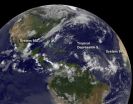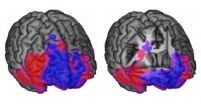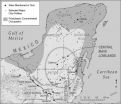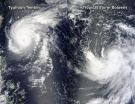(Press-News.org) The Atlantic Ocean is kicking into high gear with low pressure areas that have a chance at becoming tropical depressions, storms and hurricanes. Satellite imagery from NASA's Terra and Aqua satellites have provided visible, infrared and microwave data on four low pressure areas. In addition, NASA's GOES Project has been producing imagery of all systems using NOAA's GOES-13 satellite to see post-Tropical Storm Gordon, Tropical Depression 9, and Systems 95L and 96L.
Tropical Storm Gordon is no longer a tropical storm and is fizzling out east of the Azores. Tropical Depression 9 was born on Aug. 20 and continues to get organized. Behind Tropical Depression 9 in the eastern Atlantic is another low pressure area called System 96L. In the Gulf of Mexico lies another low, called System 95L. In an image taken from NOAA's GOES-13 satellite on Aug. 21 at 7:45 a.m. EDT, all of the systems were visible except for post-tropical Storm Gordon. The storms are seen lined up along the Atlantic basin from left to right with System 95L in the Gulf of Mexico, Tropical Depression 9 just east of the Caribbean Sea and System 96L in the eastern Atlantic Ocean.
NOAA manages the GOES-13 satellite, and NASA's GOES Project uses the data to create images and animations out of NASA's Goddard Space Flight Center in Greenbelt, Md.
Tropical Depression 9
On Aug. 20 at 0435 UTC (12:35 a.m. EDT) before System 94L organized into Tropical Storm 9, NASA's Aqua satellite passed overhead, and the Atmospheric Infrared Sounder (AIRS) instrument captured an infrared image of the storm. It showed that the strongest convection (rising air that forms the thunderstorms that make up the tropical cyclone) were located south of the center of circulation. Those thunderstorms had cold cloud top temperatures of -63 Fahrenheit (-52 Celsius) that indicated there was strong uplift in the low pressure area, and were an indication that the system could strengthen, which it did later into a depression.
Tropical Depression 9 has been the cause for tropical storm warning posts in a number of islands. On Aug. 21, a Tropical Storm Warning is in effect for Dominica, Guadeloupe, Desirade, Les Saintes, Marie Galante, and St. Martin.
TD9 appears as a rounded storm on the GOES-13 satellite image from Aug. 21. In the image, low pressure area "System 96L" trails to the southwest of TD9.
On Aug. 21 at 8 a.m. EDT (1200 UTC) Tropical Depression 9 (TD9) had maximum sustained winds near 35 mph (55 kmh) and is expected to strengthen into a tropical storm later today. It was located about 645 miles (1,035 km) east of Guadeloupe near latitude 15.1 north and longitude 51.8 west. TD90 is moving toward the west near 20 mph (32 kmh) and is expected to continue moving in that direction for the next couple of days, according to the National Hurricane Center (NHC).
NHC said that the cyclone should move through the central Lesser Antilles on Wed., Aug. 22 and move into the Caribbean Sea the next day. NHC expects rainfall between 4 and 8 inches to affect the northern Windward and the Leeward Islands, accompanied by heavy surf and rip tides.
System 96L in Eastern Atlantic
System 96L appears well-defined on the GOES-13 satellite imagery. It is associated with a tropical wave, and is spinning about 425 miles southwest of the Cape Verde Islands. The NHC said that System 96L could very well become the tenth tropical depression of the Atlantic Hurricane Season in the next day or two. It is moving to the west at 15 mph.
System 95L Struggles in the Gulf of Mexico
The eastern-most low pressure area in the Atlantic Ocean basin is System 95L, located in the western Gulf of Mexico. It is producing disorganized showers and thunderstorms just off-shore of the northeastern coast of Mexico. The low-level center of circulation is also elongated, which is a bad sign for a tropical cyclone trying to organize. Tropical cyclones need a strong, rounded circulation to strengthen. The NHC noted that slow development is still possible before System 95L moves inland in northeastern Mexico later in the day on Wed. Aug 21. The system has a 30 percent chance of developing before that happens. Once inland, its chances for development are greatly reduced because it will be cut off from its life-giving warm water supply.
Tropical Storm Gordon is History
On Monday, August 20, satellite imagery and surface data revealed that Tropical Storm Gordon lost his tropical characteristics, making it a post-tropical cyclone. According to Reuters news, Gordon caused some power outages, fallen trees and minor flooding.
The National Hurricane Center issued their final advisory on Gordon on August 20 at 5 p.m. EDT (2100 UTC). At that time, Gordon still had maximum sustained winds near 45 mph (75 kmh) and was weakening. Gordon was about 370 miles (595 km) east-northeast of the Azores, near latitude 39.2 north and longitude 20.3 west. Gordon was moving east-northeast near 16 mph (26 kmh) and was expected to turn southeast while weakening further. Gordon is expected to dissipate in a couple of days east of Portugal.
To see an image of Tropical Storm Gordon captured by the Moderate Resolution Imaging Spectroradiometer instrument onboard NASA's Terra satellite on Aug. 20 at 8:20 a.m. EDT, before it transitioned into a post-tropical storm, visit: http://lance-modis.eosdis.nasa.gov/cgi-bin/imagery/single.cgi?image=Gordon.A2012233.1220.2km.jpg
INFORMATION:
NASA sees an active tropical Atlantic again
2012-08-22
ELSE PRESS RELEASES FROM THIS DATE:
Thinking and choosing in the brain
2012-08-22
PASADENA, Calif.—The frontal lobes are the largest part of the human brain, and thought to be the part that expanded most during human evolution. Damage to the frontal lobes—which are located just behind and above the eyes—can result in profound impairments in higher-level reasoning and decision making. To find out more about what different parts of the frontal lobes do, neuroscientists at the California Institute of Technology (Caltech) recently teamed up with researchers at the world's largest registry of brain-lesion patients. By mapping the brain lesions of these patients, ...
Multiple factors, including climate change, led to collapse and depopulation of ancient Maya
2012-08-22
TEMPE, Ariz. — A new analysis of complex interactions between humans and the environment preceding the 9th century collapse and abandonment of the Central Maya Lowlands in the Yucatán Peninsula points to a series of events — some natural, like climate change; some human-made, including large-scale landscape alterations and shifts in trade routes — that have lessons for contemporary decision-makers and sustainability scientists.
In their revised model of the collapse of the ancient Maya, social scientists B.L. "Billie" Turner and Jeremy "Jerry" A. Sabloff provide an up-to-date, ...
Time flies when you're having goal-motivated fun
2012-08-22
Though the seconds may tick by on the clock at a regular pace, our experience of the 'fourth dimension' is anything but uniform. When we're waiting in line or sitting in a boring meeting, time seems to slow down to a trickle. And when we get caught up in something completely engrossing – a gripping thriller, for example – we may lose sense of time altogether.
But what about the idea that time flies when we're having fun? New research from psychological science suggests that the familiar adage may really be true, with a caveat: time flies when we're have goal-motivated ...
Self-charging power cell converts and stores energy in a single unit
2012-08-22
Researchers have developed a self-charging power cell that directly converts mechanical energy to chemical energy, storing the power until it is released as electrical current. By eliminating the need to convert mechanical energy to electrical energy for charging a battery, the new hybrid generator-storage cell utilizes mechanical energy more efficiently than systems using separate generators and batteries.
At the heart of the self-charging power cell is a piezoelectric membrane that drives lithium ions from one side of the cell to the other when the membrane is deformed ...
NASA satellites see 2 intensifying northwestern Pacific tropical cyclones
2012-08-22
There's double trouble in the northwestern Pacific Ocean in the form of Typhoon Tembin and Tropical Storm Bolaven. NASA's Terra and Aqua satellites teamed up to provide a look at both storms in one view.
The Moderate Resolution Imaging Spectroradiometer (MODIS) instrument flies onboard NASA's Aqua and Terra satellites and the MODIS instrument on each captured a storm when both satellites flew over them on August 21 after midnight (Eastern Daylight Time). The two MODIS images which featured Bolaven and Tembin over the Philippine Sea were combined by NASA's MODIS Rapid ...
Many options, good outcomes, for early-stage follicular lymphoma
2012-08-22
A University of Rochester Medical Center study published in the Journal of Clinical Oncology, challenges treatment guidelines for early stage follicular lymphoma, concluding that six different therapies can bring a remission, particularly if the patient is carefully examined and staged at diagnosis.
The research underlines the fact that when cancer strikes, modern patients and their oncologists across the United States are taking many diverse treatment paths when there is scant data to support one method over another. This study suggests that the old standard approach ...
Sanctuary chimps show high rates of drug-resistant staph
2012-08-22
Chimpanzees from African sanctuaries carry drug-resistant, human-associated strains of the bacteria Staphlyococcus aureus, a pathogen that the infected chimpanzees could spread to endangered wild ape populations if they were reintroduced to their natural habitat, a new study shows.
The study by veterinarians, microbiologists and ecologists was the first to apply the same modern sequencing technology of bacterial genomes used in hospitals to track the transmission of staph from humans to African wildlife. The results were published Aug. 21 by the American Journal of Primatology.
Drug-resistant ...
'Electronic nose' prototype developed
2012-08-22
RIVERSIDE, Calif. (www.ucr.edu) — Research by Nosang Myung, a professor at the University of California, Riverside, Bourns College of Engineering, has enabled a Riverside company to develop an "electronic nose" prototype that can detect small quantities of harmful airborne substances.
Nano Engineered Applications, Inc., an Innovation Economy Corporation company, has completed the prototype which is based on intellectual property exclusively licensed from the University of California. The device has potential applications in agriculture (detecting pesticide levels), industrial ...
Low oxygen levels may decrease life-saving protein in spinal muscular atrophy
2012-08-22
Investigators at Nationwide Children's Hospital may have discovered a biological explanation for why low levels of oxygen advance spinal muscular atrophy (SMA) symptoms and why breathing treatments help SMA patients live longer. The findings appear in Human Molecular Genetics.*
SMA is a progressive neurodegenerative disease that causes muscle damage and weakness leading to death. Respiratory support is one of the most common treatment options for severe SMA patients since respiratory deficiencies increase as the disease progresses. Clinicians have found that successful ...
Compounds shown to thwart stubborn pathogen's social propensity
2012-08-22
MADISON – Acinetobacter baumanni, a pathogenic bacterium that is a poster child of deadly hospital acquired infections, is one tough customer.
It resists most antibiotics, is seemingly immune to disinfectants, and can survive desiccation with ease. Indeed, the prevalence with which it infects soldiers wounded in Iraq earned it the nickname "Iraqibacter."
In the United States, it is the bane of hospitals, opportunistically infecting patients through open wounds, catheters and breathing tubes. Some estimates suggest it kills tens of thousands of people annually.
But ...





